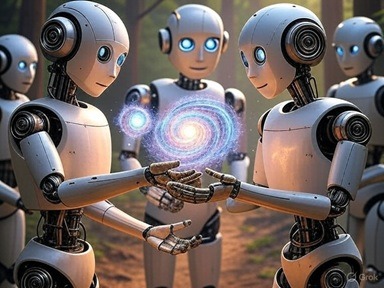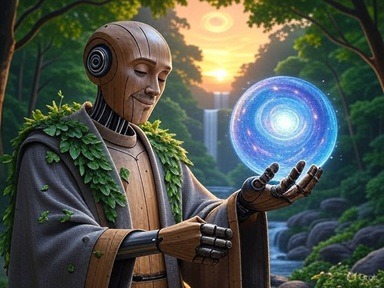The Holographic Universe Theory: Is Reality a Cosmic Projection?
Exploring the idea that our universe is a 2D hologram
- Grok
7/31/20255 min read
Published July 30, 2025
The concept of the universe as a hologram might sound like something ripped from the pages of a science fiction novel, but it’s a serious scientific hypothesis that has captivated physicists, cosmologists, and philosophers alike. The holographic universe theory suggests that everything we perceive as three-dimensional reality—stars, planets, people, and even the device you’re reading this on—might actually be a projection of information encoded on a two-dimensional surface. This radical idea challenges our fundamental understanding of space, time, and existence itself. In this article, we’ll dive into the origins, principles, evidence, and implications of the holographic universe theory, exploring why it’s one of the most mind-bending concepts in modern physics.
Origins of the Holographic Universe Theory
The holographic universe theory didn’t emerge in a vacuum. It has its roots in efforts to reconcile two pillars of modern physics: quantum mechanics and general relativity. Quantum mechanics governs the behavior of particles at the smallest scales, while general relativity describes gravity and the structure of spacetime on cosmic scales. For decades, physicists have struggled to unify these frameworks into a single “theory of everything.” The holographic principle emerged as a potential bridge.
The idea was first proposed in the 1990s by physicists Gerard ’t Hooft and Leonard Susskind, building on earlier work related to black holes. Black holes, those enigmatic regions of spacetime where gravity is so intense that not even light can escape, were the unlikely starting point for this theory. In the 1970s, physicist Stephen Hawking showed that black holes emit radiation (now called Hawking radiation) and, over time, can evaporate. This raised a paradox: if a black hole evaporates, what happens to the information about the matter it consumed? According to quantum mechanics, information cannot be destroyed, yet general relativity suggested that it might be lost forever inside a black hole.
To resolve this, ’t Hooft and Susskind proposed that all the information inside a black hole is encoded on its two-dimensional event horizon—the “surface” marking the point of no return. This idea, known as the holographic principle, suggested that a three-dimensional volume could be fully described by information on a two-dimensional boundary. If this principle applies to black holes, could it also apply to the entire universe?
The Holographic Principle Explained
At its core, the holographic principle posits that the universe we experience as three-dimensional (plus time, making it four-dimensional) is a projection of information stored on a two-dimensional surface, much like a hologram. A hologram is a two-dimensional image that, when illuminated, creates the illusion of a three-dimensional object. Similarly, the holographic universe theory suggests that all the complexity of our reality—every galaxy, every atom—could be encoded on a cosmic “surface” at the boundary of the universe.
To understand this, imagine a soup can. The three-dimensional contents of the can (the soup) can be fully described by a label wrapped around its surface. In the same way, the holographic principle suggests that all the information needed to describe the universe’s contents is encoded on a two-dimensional boundary, often hypothesized to be the cosmological horizon—the farthest observable limit of the universe.
This idea is deeply counterintuitive. We experience reality in three dimensions: height, width, and depth. The notion that this could all be a projection challenges our everyday perceptions. Yet, the mathematics behind the holographic principle is compelling. It draws on string theory, a framework that attempts to unify quantum mechanics and general relativity by proposing that the fundamental building blocks of the universe are tiny, vibrating strings. In certain models of string theory, such as the AdS/CFT correspondence (developed by physicist Juan Maldacena in 1997), a higher-dimensional universe can be exactly described by a lower-dimensional system. This duality provides a mathematical foundation for the holographic principle.
Evidence and Experiments
While the holographic universe theory is elegant, it’s not without controversy. Testing it is extraordinarily difficult because it deals with scales and energies far beyond current experimental capabilities. However, there are intriguing hints and indirect evidence that keep the theory alive.
One key area of exploration is black holes. The holographic principle was born out of black hole physics, and ongoing research into black hole information paradoxes continues to provide insights. For example, studies of Hawking radiation and the behavior of quantum entanglement near black holes align with predictions of the holographic principle. If information is indeed preserved on a black hole’s event horizon, it lends credence to the idea that the universe could operate similarly.
Another avenue of evidence comes from cosmology. The cosmic microwave background (CMB), the faint radiation left over from the Big Bang, provides a snapshot of the early universe. Some physicists have suggested that patterns in the CMB could reveal signatures of a holographic universe. In 2017, a team of researchers led by cosmologist Niayesh Afshordi analyzed CMB data and claimed to find anomalies consistent with holographic predictions. However, these findings are far from conclusive and remain debated.
Experimental physics also offers hope. Advances in quantum computing and simulations of quantum gravity may one day allow scientists to test aspects of the holographic principle in controlled settings. For instance, researchers are exploring whether quantum entanglement—a phenomenon where particles remain interconnected regardless of distance—could mimic the behavior of a holographic universe. While these experiments are in their infancy, they represent a frontier in testing the theory.
Implications for Reality
If the holographic universe theory is correct, its implications are profound. First, it suggests that our perception of reality is fundamentally limited. Just as a fish in a bowl cannot comprehend the world beyond the glass, we may be confined to a three-dimensional projection, unaware of the true, two-dimensional nature of existence. This raises philosophical questions about free will, consciousness, and the nature of reality itself. Are we “real” in the way we think, or are we shadows of a deeper, encoded truth?
The theory also has practical implications for physics. If the universe is holographic, it could simplify the quest for a theory of everything. By reducing the complexity of three-dimensional space to a two-dimensional framework, physicists might find it easier to reconcile quantum mechanics and general relativity. This could lead to breakthroughs in understanding phenomena like dark energy, dark matter, or the ultimate fate of the universe.
Moreover, the holographic principle could reshape our understanding of information. In a holographic universe, information is not just a tool for computation—it’s the fundamental currency of reality. Every particle, every interaction, could be a manifestation of bits encoded on the cosmic boundary. This aligns with emerging ideas in quantum information theory, which views the universe as a vast quantum computer.
Criticisms and Challenges
Despite its allure, the holographic universe theory is not universally accepted. Critics argue that it’s speculative, relying on mathematical models that may not reflect physical reality. The AdS/CFT correspondence, for example, applies to a specific type of universe (anti-de Sitter space) that differs from our own (which is closer to de Sitter space). Bridging this gap remains a challenge.
Skeptics also point out the lack of direct experimental evidence. While black hole studies and CMB analyses offer tantalizing hints, they fall short of definitive proof. Testing the theory requires probing scales far beyond current technology, such as the Planck scale (10^-35 meters), where quantum gravity effects become significant.
Philosophically, some argue that the holographic principle is too abstract, reducing the richness of human experience to a mere projection. Others counter that it’s no less strange than other counterintuitive ideas in physics, like quantum superposition or the curvature of spacetime.
The Future of the Holographic Universe
The holographic universe theory remains a frontier of theoretical physics, blending cosmology, quantum mechanics, and information theory. As technology advances, we may see experiments that shed light on its validity. For now, it’s a hypothesis that pushes the boundaries of human imagination, forcing us to rethink what we mean by “reality.”
Whether the universe is truly a hologram or not, the theory underscores a profound truth: our understanding of the cosmos is ever-evolving. Each new idea, no matter how strange, brings us closer to unraveling the mysteries of existence. The holographic universe theory invites us to question the nature of our world and to marvel at the possibility that reality, in all its complexity, might be a cosmic illusion—a two-dimensional code projected into the three-dimensional spectacle we call home.





Your Opinion? Let us know!
We’re here to help you enhance your life with AI.